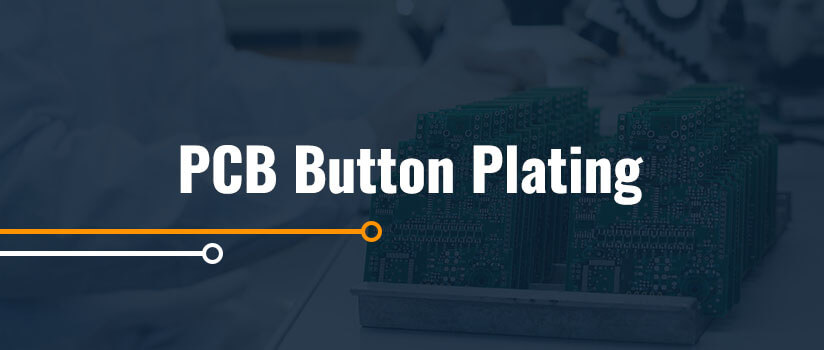Table of Contents:
When you want to produce a flexible printed circuit board (PCB) that has exceptional impedance control or dynamic flexibility, PCB button plating is crucial. This fabrication process is widely used in the PCB industry to better protect PCBs while still keeping them malleable enough to work in various flex applications. Knowing how PCB button plating works can help you make an informed decision about whether you need it when you’re interested in a new PCB.
Find out more about what PCB button plating is and why it’s used. You may also want to know PCB button plating’s primary applications.
What Is PCB Button Plating? What Is Pads Only Plating?
PCB button plating, sometimes called pads only plating, refers to a particular fabrication process used for flex PCBs. This process involves electroplating copper to a PCB’s vias and onto the pads responsible for capturing the vias. In the process of button plating, the areas of the plated through hole (PTH) and supporting pads are only plated, with no plating installed on copper traces.
When someone button plates a PCB, they’ll first create a plating pattern designed to resist opening at the PCB’s holes. After this step, they’ll then only plate the vias and small pads at the holes. Once the vias are plated, a designer will strip off the resist. With resist stripped off, the designer then uses an etch process to etch away the PCB’s base copper.
This process allows you to use the base copper to create an etched pattern featuring buttons or pads at its holes. This additional image operation allows the designer to better define the circuit traces responsible for connecting pads. Since plating over copper would harm its flexibility, manufacturers avoid placing copper over the pattern, only sticking to plating supporting pads and the PTH.
Button plating gets its name due to its appearance. Once a product is finished with the button plating process, you’ll see it has a flat surface with raised areas that resemble buttons. These buttons come from the PTH, as the PTH will be slightly higher than the product’s other copper elements.
Why Is Button Plating Used?
Companies often use PCB button plating because it helps avoid impedance and flexibility problems of other methods. Since this fabrication process doesn’t involve placing any plating on the copper tracing, you don’t have the flexibility issues associated with copper constructions. For example, rigid PCBs’ copper tends to reduce flexibility, so companies use PCB button plating for flex PCBs to raise their flexibility by only plating certain areas.
More specifically, you can find button plating used to facilitate impedance control at higher speeds, as it provides support to homogenous base copper. Companies also use it since it only needs a single rolled annealed (RA) copper deposit, which supports devices requiring bending applications. You can see companies using button plating when they need to produce a product with a PTH featuring a heavier copper deposit, as this process won’t place this deposit across the outer layers’ surface.
Miniaturization is another concern of those using flex PCBs, and PCB button plating assists with producing smaller PCBs. PCB button plating gives you the ability to utilize PCBs with smaller line spacing and width. This ability can be very helpful if you need miniaturization, as it can help reduce the PCB’s overall size. With smaller widths and spacing, you can place more features and electronic components much closer together.
Button Plating Applications
The two main button plating applications are seen in PCBs needing impedance control or dynamic flex designs. Dynamic flex designs are often required when the flex circuit needs frequent or continuous bending. Impedance control designs are usually needed for PCBs requiring high signal speeds.
Find out more about how button plating assists with these two design types below:
Impedance Control
PCBs utilizing high-speed electronics usually need impedance control. Impedance control refers to the process of measuring specific traces’ impedance. This measuring occurs while the PCB is manufactured to ensure the PCB meets the parameters set by the designer. A PCB with proper impedance control will protect the transferred data from damage and maintain its signal’s clarity.
PCBs with exceptional impedance control often consist of homogeneous dielectric material. They’ll also have consistent copper spacing, thickness and width. Finally, these PCBs will feature an equivalent dielectric thickness spacing between the bottom and top ground plates.
Since these materials tend to have more variable electroplated copper thicknesses, you’ll often see a significant amount of variation in the copper plating thickness of a circuit. These variations often result from current densities causing features to plate at lower or higher rates. Due to this variation, a great deal of fluctuation in the impedance can occur. Button plating assists with impedance control for these PCBs, as it will help reduce variability between various product builds or inside an individual part.
Dynamic Flex
At times, flexible circuit applications require a circuit to flex while someone uses the device. For example, laptops rely on flexible circuits to flex thousands of times when a user opens and closes them. Dynamic flex refers to a design where the PCB can safely flex during operation.
Dynamic flex PCBs will utilize a unique number of factors to ensure the PCB can flex without breaking. Some of these factors include bend radius, motion and cycle acceleration, with all of them potentially affecting a PCB’s flex life. Many times, PCB designers will avoid using electroplated copper for dynamic flex applications, as this material’s grain structure makes it so a PCB is more likely to break over repeated bending and causes the PCB to be more rigid.
Button plating plays a crucial role in dynamic flex PCBs, as this process doesn’t plate over the copper traces. Due to the lack of plating on the copper traces, the PCB will be much more flexible and likely to last a long time in flex applications. Button plating gives designers an excellent alternative to electroplated copper, providing the PCB with malleability it needs to not break due to repeated bending.
Choose MCL for Your PCB Button Plating Needs
At Millennium Circuits Limited, we’re ready to handle your PCB button plating needs. When you have PCBs requiring a dynamic flex design or impedance control, we can ensure you receive the best PCB button plating services possible. As a PCB supplier, we regularly provide our clients with various PCB types to ensure they receive the best PCBs for their unique requirements. Some of our popular PCB types include rigid flex and flex PCBs.
If you’re ready to receive our PCB button plating services, take a moment to request a quick quote. Please feel free to contact us if you have any questions.




